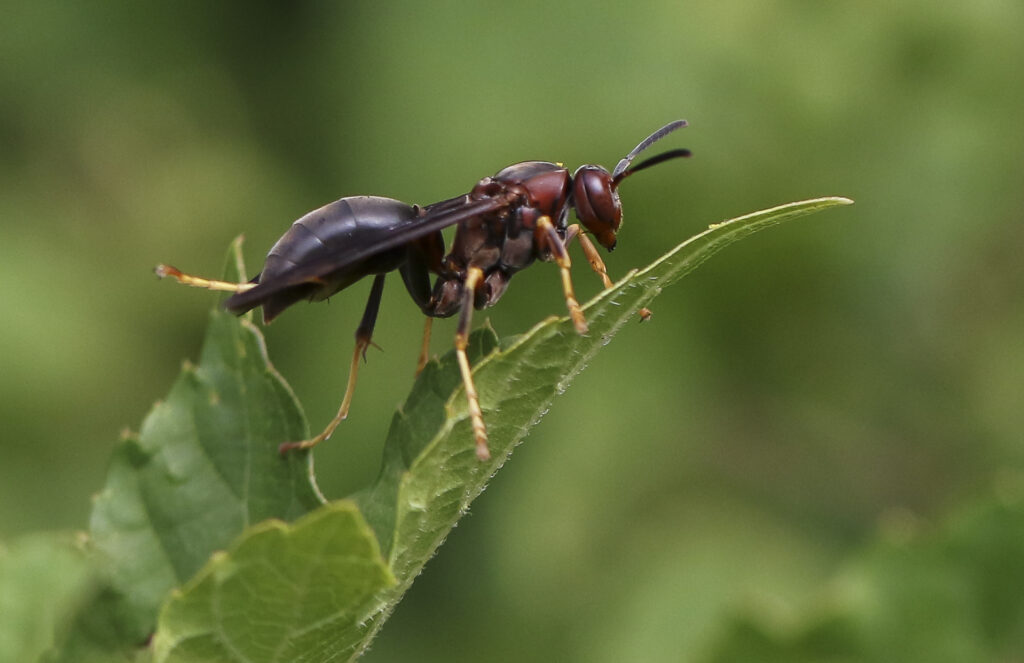Paper Wasps: Keep Your Distance and Let Them Do Wasp Things

By Wayne Bierbaum
Volunteers were working in the butterfly gardens at Jug Bay Wetlands Sanctuary when there came a loud gasp followed by the sound of dropping tools and then a scattering of bodies. Someone called out, “Wasps!” and it was evident that a wasp nest had been disturbed. I saw 10 to 20 large dark wasps circling the area where the tools were dropped.
After the swarm calmed down, I slowly walked back to the garden to find the wasps’ origin. I was surprised to see a large papery nest hidden under a plant on the ground. Several dark red wasps were walking on and around the nest. They eventually ceased acting aggressively and no one was stung.
The insect was the northern paper wasp. Although they are large and can sting multiple times, they are not considered aggressive—at least not like a yellow jacket. They will defend their nest and protect themselves.
Paper wasps earned that moniker because they chew wood and use their saliva to convert the wood to paper. The paper is used to build a nest, usually resembling an upside-down goblet with multiple vertical chambers. The wasps build the nests in a spot protected from rain, like under a rarely used picnic table or the eaves of a house. Paper wasps will sometimes nest in unexpected places like the horizontal pipe of a metal swing set but they rarely nest on or under the ground, which is why the nest in the butterfly garden was surprising.
The northern paper wasp is the most common wasp in our area and can be found from Central America to southern Canada. The more aggressive red wasp can also be found in our area but they tend to be more of a southern species. The red wasp’s body is a brighter red with almost no black except for its black wings. The northern paper wasp has a black thorax and a dark red abdomen with thin yellow stripes.
The northern paper wasp is a social insect and lives in a matriarchal society. At the end of the summer, fertile females and males hatch and mate before seeking shelter for the winter. In the spring, the females leave to start their brooding nests.
The first series of eggs that hatch are infertile males. The worker males will go out and forage for food, protect and enlarge the nest, and take care of the eggs and larvae. The more successful the food gathering is, the larger the nest becomes and the more new eggs are laid.
Each of the eggs is marked by the originating female and if an unrecognized egg is snuck in by a competing female, that egg will be destroyed. There is only one queen per nest.
By the end of fall, the wasps that were born in the spring and early summer all die, including the queen, and the new now-mature fertile females will look for a spot to spend the winter. The new life cycle begins.
The wasps are omnivores and will feed on nectar and pollen as well as small insects. Because the wasps collect caterpillars to feed developing larvae, they are considered beneficial insects. A large population of northern paper wasps will significantly reduce the caterpillar burden in a garden.
A paper wasp will sting when protecting a nest or when threatened. Most stings occur when there is a nest in an unexpected location. When you see several dark wasps in your yard, try to follow one back to the nest so you know where to avoid them. When one lands on me, I have found that gently brushing a wasp away, preferably with a piece of paper, avoids angering the wasp. The sting is painful and it can be dangerous when a severe allergic reaction, anaphylaxis, is involved. If epinephrine is given quickly it can briefly decrease the severity of anaphylaxis but an immediate trip to an ER is needed for further treatment. Call emergency services in the case of true anaphylactic shock.
Wasps bring balance to an ecosystem. They act as pollinators and pest removers. They should be allowed to coexist with us. That being said, I do think that removing a nest from areas of play or picnicking reduces the chance of children being stung.
Back to the butterfly garden—caution tape was placed in a 3-foot perimeter around the nest. The tools were picked up and garden maintenance continued with no further excitement.
